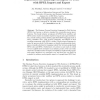Free Online Productivity Tools
i2Speak
i2Symbol
i2OCR
iTex2Img
iWeb2Print
iWeb2Shot
i2Type
iPdf2Split
iPdf2Merge
i2Bopomofo
i2Arabic
i2Style
i2Image
i2PDF
iLatex2Rtf
Sci2ools
BPM
2006
Springer
2006
Springer
Experiences in Enhancing Existing BPM Tools with BPEL Import and Export
The Business Process Execution Language for Web Services (BPEL) has become a de-facto standard for executable process specifications. The broad industry acceptance of BPEL forces workflow and BPM system vendors to consider respective import and export interfaces. Yet, several existing systems utilize graph-based BPM languages such as EPCs, Workflow Nets, UML Activity Diagrams, and BPMN in their modeling component while BPEL is rather a block-oriented language inspired by process calculi. In this paper we identify transformation strategies as reusable solutions for mapping control flow between graph-based BPM tools and BPEL. Furthermore, we present a case study in which we have applied these strategies in an industry project. This case study shows that transformation strategies are helpful for implementing import and export interfaces in a systematic way, and that they can easily be extended to address vendor-specific aspects of a graph-based BPM tool.
| Added | 20 Aug 2010 |
| Updated | 20 Aug 2010 |
| Type | Conference |
| Year | 2006 |
| Where | BPM |
| Authors | Jan Mendling, Kristian Bisgaard Lassen, Uwe Zdun |
Comments (0)

